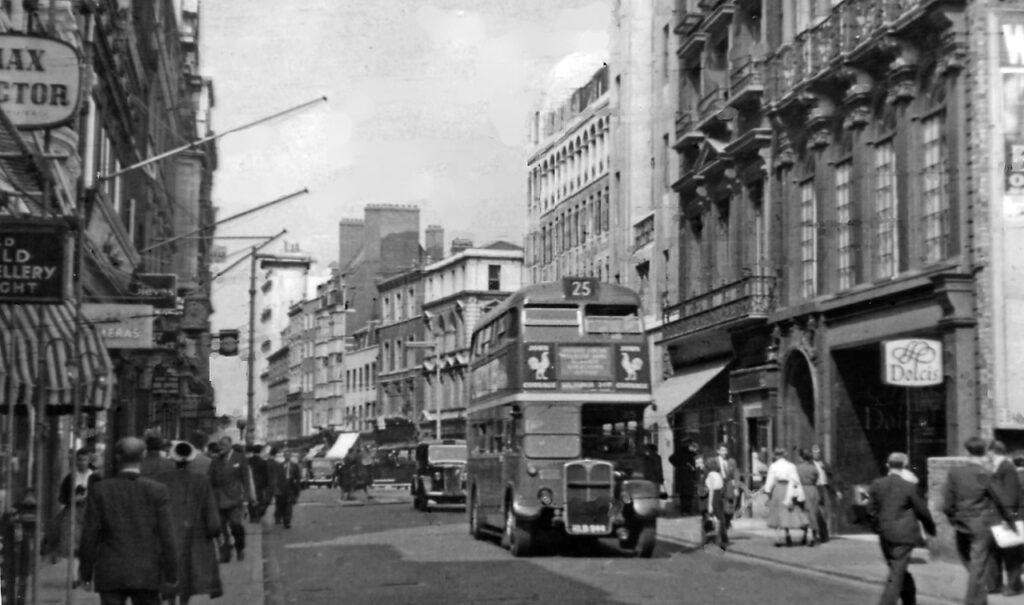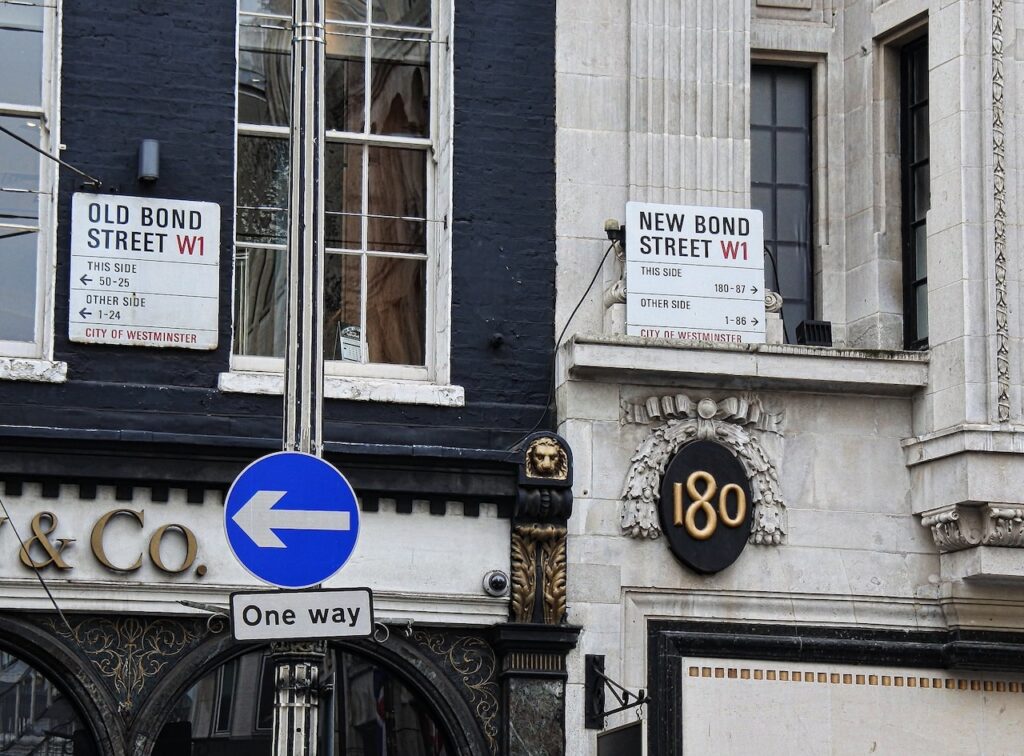bond street, london: a local’s guide to the capital’s most fashionable street
Discover Bond Street’s heritage, shops, and reputation – find out what to see, do, eat and drink
Discover Bond Street’s heritage, shops, and reputation – find out what to see, do, eat and drink
“Old Bond Street” by garryknight is licensed under CC BY 2.0
For over three centuries, Bond Street’s half mile thoroughfare has been a catwalk for the most stylish, from Georgian fashion icons like Beau Brummell to its modern status as a designer fashion hub. This guide reveals the stories and secrets of a street that remains the ultimate destination for discerning tastes. To quote the poet Edward Bulwer Lytton, “And now our Brothers Bond Street enter / Dear Street of London’s charms the centre…”

Officially speaking, Bond Street doesn’t exist. The street is in fact two: Old Bond Street to the south and New Bond Street to the north. But today, Londoners simply call the whole thing Bond Street.
Stretching from Piccadilly to Oxford Street, Bond Street slices through the heart of Mayfair, one of London’s most exclusive districts. Old Bond Street was completed around 1686, and the northern extension of New Bond Street followed shortly after in 1700, creating the bustling street we know today. It underwent significant redevelopment in the 1720s when Sir Thomas Bond, a property developer, began building on fields surrounding Clarendon House.
From the beginning, the street was favoured by London’s elite. It featured raised stone pavements, an innovative solution that allowed wealthy shoppers to browse its fashionable storefronts without treading in the muck of the 18th century street below. Its status as a most prestigious shopping quarter was cemented in 1784 when Georgiana Cavendish, the influential Duchess of Devonshire, known as the Empress of Fashion (she even employed a full-time Parisian hairdresser) orchestrated a political boycott of the popular shopping destination Covent Garden. Charismatic and beautiful, she diverted high society’s attention and spending power to Bond Street, setting the stage for its enduring legacy as a centre of style.
During the Georgian period the street became the catalyst for evolving fashion, moving away from the gaudy, ostentatious attire of the early Georgians towards a more refined and understated elegance. This shift was championed by figures like George ‘Beau’ Brummell, the son of a tailor who became a celebrated arbiter of taste and London’s ultimate dandy. As The Telegraph notes, “His understated elegance had an influence far beyond London, and many would credit his style philosophy with the eventual rise of the three-piece suit as the classic gentleman’s attire”. Individuals like Brummell helped establish Bond Street as the birthplace of a new kind of celebrity, one defined by wit and personal style rather than aristocratic lineage.
By the late 18th century, the street’s reputation as the pinnacle of fashion had given rise to a unique subculture: the Bond Street Loungers. Defined as “a person of high fashion, whose sole purpose was to display their exquisite taste by parading the wide pavements around Bond Street”, they were known for their expensive wigs and flashy dress sense. They even had a distinctive walk known as the Bond Street Roll. A key part of any Lounger’s daily ritual was, apparently, to scan the newspapers to see if their names appeared on lists of attendees at fashionable events.

Bond Street, London, boasts one of the highest concentrations of haute couture and luxury brands in Europe. You’ll find Chanel, Dior, Cartier, De Beers, Omega, Prada, McQueen and Tiffany here, amongst many other world famous labels. Here are just a few of our favourites:
This purveyor of jewellery, leather, silver and other luxury goods has a history that spans over three centuries. It was founded in 1781 by William Asprey as a silk printing business, just outside London. In 1841, William Asprey’s son, Charles, moved the business to London’s Bond Street. After occupying its historic home at 167 New Bond Street for two centuries, Asprey now welcomes clients to its new location just steps away on Bruton Street.
Location: 36 Bruton Street, London W1J 6QX
Website
At 107 New Bond Street you’ll find the French perfumier Diptyque’s flagship London store, where Parisian elegance and refinement underpin a sensory experience that explores nature, travel and art. Enjoy a fragrance consultation and discover exclusive creations and artist editions not found in department stores or concessions.
Location: 107 New Bond Street, London W1S 1ED
Website
Nestled at 17–20 New Bond Street, Louis Vuitton is renowned for dazzling window shoppers with colourful and dynamic façades. The French fashion house’s London flagship store offers a full spectrum of leather goods, accessories, and prêt-à-porter within an interior that blends classic artistry with contemporary flair – it’s simply a must for style connoisseurs.
Location: 17–20 New Bond Street, London W1S 2RB
Website
The pinnacle of American sophistication in London is Ralph Lauren’s Bond Street flagship store. Formerly home to the National Westminster Bank, the building oozes refined excellence with mahogany panelling and Art Deco details. The coveted 1 New Bond Street address showcases the brand’s iconic menswear, womenswear, and premium accessories.
Location: 1 New Bond Street, London W1S 3RL
Website
For a unique experience of the iconic Swiss horological makers, visit Rolex’s flagship boutique on Old Bond Street, where you can choose your timepiece in luxury surroundings. This is also an opportunity to explore an exclusive collection of rare Rolex Certified Pre-Owned watches, each demonstrating technical innovation and classic design that lasts the test of time.
Location: 34 Old Bond Street, London W1S 4QL
Website

Beyond its fashion credentials, Bond Street has plenty to explore for the wandering art lover. At its heart lies Sotheby’s; the world famous auction house has been located at 35 New Bond Street since 1917. Before you step inside, peer skywards to see an authentic Ancient Egyptian sculpture above the entrance. This piece is reportedly from around 1600 BC, making it one of London’s oldest statues. Inside, timely visitors can witness the thrill of a live auction or find a free exhibition on show in its galleries.
The street is also home to a selection of commercial galleries. Halcyon Gallery, at number 148 New Bond Street, showcases works by Andy Warhol, David Hockney, and Bob Dylan. Nearby, you will also find Galerie Bartoux and Eden Gallery, with many other galleries on neighbouring streets.
Keep an eye out for Bond Street’s public art as you stroll. Unveiled in 1995, Allies – by self-taught sculptor Lawrence Holofcener – captures Winston Churchill and Franklin D. Roosevelt in conversation. At 153 New Bond Street works by sculptor Henry Moore adorn the façade of what is now a Loro Piana boutique. For a deeper dive into the area’s creative landscape, our comprehensive guide to Mayfair’s art scene covers the rich cultural offerings of the area.

Throughout its history, Bond Street has attracted a remarkable list of residents. Lodgers included the writer Jonathan Swift, politician George Selwyn, and former Prime Minister William Pitt the Elder. The novelist Laurence Sterne also lived here, as did Henry Fielding and the first president of the Royal Academy of Arts, Joshua Reynolds.
Famously, Admiral Lord Nelson took up temporary residence here for a year in 1797, and his mistress, Lady Hamilton, lived here from 1811 to 1813. The street was also home to the notorious Thomas Pitt, 2nd Baron Camelford, a Royal Navy Officer famous in the ton – Georgian society’s elite – for his violent and erratic behaviour (this earned him the moniker the ‘Half-Mad Lord’), who died in a duel aged 29 in 1804.
In literature, Bond Street symbolises taste and urban sophistication. From the pages of Jane Austen’s Sense and Sensibility, written in 1811, Robert Ferrars tells his father that “[a] young fellow is nothing now without the Bond Street roll, a toothpick between his teeth, and his knuckles cramm’d into his coat-pocket”.
More than 100 years later in Virginia Woolf’s 1925 Mrs Dalloway, Clarissa walks to Bond Street to buy her famous flowers: “Bond Street fascinated her; Bond Street early in the morning in the season; its flags flying; its shops; no splash; no glitter; one roll of tweed in the shop where her father had bought his suits for fifty years; a few pearls”,
Sherlock Holmes and Dr Watson also pause here in Arthur Conan Doyle’s 1902 detective novel The Hound of the Baskervilles, when Holmes suggests they “drop into one of the Bond Street picture galleries” to pass some time. Today, Bond Street remains the most expensive property from the green group on the British Monopoly board.
From Georgian promenades to its current status as a global haute couture hub, Bond Street has always been a reflection of London’s high society. Its seamless blend of fashion, art, and history makes it a destination unlike any other. It is a place where centuries of stories are embedded in the very pavements, affirming the enduring truth that “Bond Street is a name synonymous with luxury”.
Bond Street is in London’s West End, linking Piccadilly in the south to Oxford Street in the north and bisecting the exclusive neighbourhood of Mayfair.
Shops are generally open from 10am to 7pm Monday to Saturday, and from 12pm to 6pm on Sundays.
The nearest stations are Bond Street (Central, Jubilee, and Elizabeth lines), Green Park (Piccadilly, Victoria, and Jubilee lines) and Oxford Street (Central, Victoria, and Bakerloo lines). Please note that Bond Street station does not connect directly to the street itself but is a short walk away.
The street falls within W1 postcodes, primarily W1S.
There are several car parks in Mayfair, as well as pay-by-phone bays. Always check local restrictions.
Many areas are step-free, and a section of New Bond Street is pedestrianised. It is best to check with individual stores regarding their specific accessibility.
You can travel via the Tube, bus routes along Piccadilly and Oxford Street, or hail a famous black cab.
Yes, the tranquil expanses of Green Park, Berkeley Square, and Grosvenor Square are all a short walk away.
If you’re looking for a home in London with spectacular views, plenty of space, guaranteed privacy and the flexibility to furnish with your most cherished possessions, then this stunning serviced apartment ticks all the boxes.